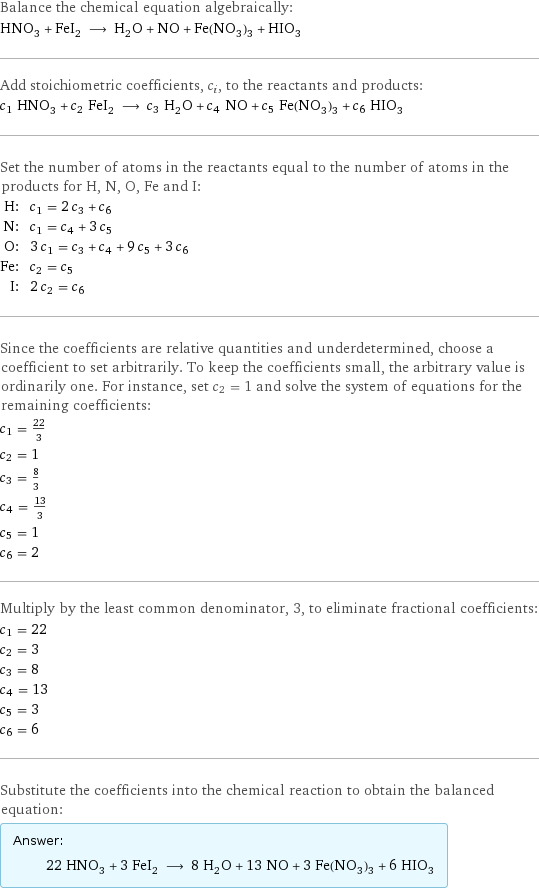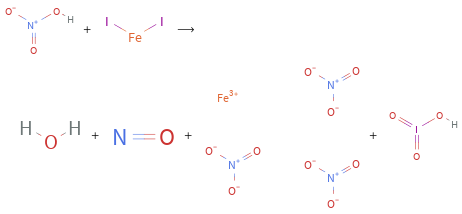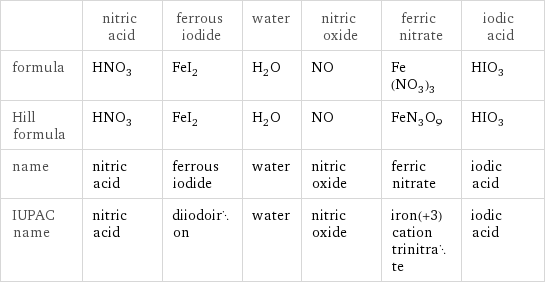Input interpretation

HNO_3 nitric acid + FeI_2 ferrous iodide ⟶ H_2O water + NO nitric oxide + Fe(NO_3)_3 ferric nitrate + HIO_3 iodic acid
Balanced equation

Balance the chemical equation algebraically: HNO_3 + FeI_2 ⟶ H_2O + NO + Fe(NO_3)_3 + HIO_3 Add stoichiometric coefficients, c_i, to the reactants and products: c_1 HNO_3 + c_2 FeI_2 ⟶ c_3 H_2O + c_4 NO + c_5 Fe(NO_3)_3 + c_6 HIO_3 Set the number of atoms in the reactants equal to the number of atoms in the products for H, N, O, Fe and I: H: | c_1 = 2 c_3 + c_6 N: | c_1 = c_4 + 3 c_5 O: | 3 c_1 = c_3 + c_4 + 9 c_5 + 3 c_6 Fe: | c_2 = c_5 I: | 2 c_2 = c_6 Since the coefficients are relative quantities and underdetermined, choose a coefficient to set arbitrarily. To keep the coefficients small, the arbitrary value is ordinarily one. For instance, set c_2 = 1 and solve the system of equations for the remaining coefficients: c_1 = 22/3 c_2 = 1 c_3 = 8/3 c_4 = 13/3 c_5 = 1 c_6 = 2 Multiply by the least common denominator, 3, to eliminate fractional coefficients: c_1 = 22 c_2 = 3 c_3 = 8 c_4 = 13 c_5 = 3 c_6 = 6 Substitute the coefficients into the chemical reaction to obtain the balanced equation: Answer: | | 22 HNO_3 + 3 FeI_2 ⟶ 8 H_2O + 13 NO + 3 Fe(NO_3)_3 + 6 HIO_3
Structures

+ ⟶ + + +
Names

nitric acid + ferrous iodide ⟶ water + nitric oxide + ferric nitrate + iodic acid
Equilibrium constant
![Construct the equilibrium constant, K, expression for: HNO_3 + FeI_2 ⟶ H_2O + NO + Fe(NO_3)_3 + HIO_3 Plan: • Balance the chemical equation. • Determine the stoichiometric numbers. • Assemble the activity expression for each chemical species. • Use the activity expressions to build the equilibrium constant expression. Write the balanced chemical equation: 22 HNO_3 + 3 FeI_2 ⟶ 8 H_2O + 13 NO + 3 Fe(NO_3)_3 + 6 HIO_3 Assign stoichiometric numbers, ν_i, using the stoichiometric coefficients, c_i, from the balanced chemical equation in the following manner: ν_i = -c_i for reactants and ν_i = c_i for products: chemical species | c_i | ν_i HNO_3 | 22 | -22 FeI_2 | 3 | -3 H_2O | 8 | 8 NO | 13 | 13 Fe(NO_3)_3 | 3 | 3 HIO_3 | 6 | 6 Assemble the activity expressions accounting for the state of matter and ν_i: chemical species | c_i | ν_i | activity expression HNO_3 | 22 | -22 | ([HNO3])^(-22) FeI_2 | 3 | -3 | ([FeI2])^(-3) H_2O | 8 | 8 | ([H2O])^8 NO | 13 | 13 | ([NO])^13 Fe(NO_3)_3 | 3 | 3 | ([Fe(NO3)3])^3 HIO_3 | 6 | 6 | ([HIO3])^6 The equilibrium constant symbol in the concentration basis is: K_c Mulitply the activity expressions to arrive at the K_c expression: Answer: | | K_c = ([HNO3])^(-22) ([FeI2])^(-3) ([H2O])^8 ([NO])^13 ([Fe(NO3)3])^3 ([HIO3])^6 = (([H2O])^8 ([NO])^13 ([Fe(NO3)3])^3 ([HIO3])^6)/(([HNO3])^22 ([FeI2])^3)](../image_source/9c68c1071b4cec738038407c9796233b.png)
Construct the equilibrium constant, K, expression for: HNO_3 + FeI_2 ⟶ H_2O + NO + Fe(NO_3)_3 + HIO_3 Plan: • Balance the chemical equation. • Determine the stoichiometric numbers. • Assemble the activity expression for each chemical species. • Use the activity expressions to build the equilibrium constant expression. Write the balanced chemical equation: 22 HNO_3 + 3 FeI_2 ⟶ 8 H_2O + 13 NO + 3 Fe(NO_3)_3 + 6 HIO_3 Assign stoichiometric numbers, ν_i, using the stoichiometric coefficients, c_i, from the balanced chemical equation in the following manner: ν_i = -c_i for reactants and ν_i = c_i for products: chemical species | c_i | ν_i HNO_3 | 22 | -22 FeI_2 | 3 | -3 H_2O | 8 | 8 NO | 13 | 13 Fe(NO_3)_3 | 3 | 3 HIO_3 | 6 | 6 Assemble the activity expressions accounting for the state of matter and ν_i: chemical species | c_i | ν_i | activity expression HNO_3 | 22 | -22 | ([HNO3])^(-22) FeI_2 | 3 | -3 | ([FeI2])^(-3) H_2O | 8 | 8 | ([H2O])^8 NO | 13 | 13 | ([NO])^13 Fe(NO_3)_3 | 3 | 3 | ([Fe(NO3)3])^3 HIO_3 | 6 | 6 | ([HIO3])^6 The equilibrium constant symbol in the concentration basis is: K_c Mulitply the activity expressions to arrive at the K_c expression: Answer: | | K_c = ([HNO3])^(-22) ([FeI2])^(-3) ([H2O])^8 ([NO])^13 ([Fe(NO3)3])^3 ([HIO3])^6 = (([H2O])^8 ([NO])^13 ([Fe(NO3)3])^3 ([HIO3])^6)/(([HNO3])^22 ([FeI2])^3)
Rate of reaction
![Construct the rate of reaction expression for: HNO_3 + FeI_2 ⟶ H_2O + NO + Fe(NO_3)_3 + HIO_3 Plan: • Balance the chemical equation. • Determine the stoichiometric numbers. • Assemble the rate term for each chemical species. • Write the rate of reaction expression. Write the balanced chemical equation: 22 HNO_3 + 3 FeI_2 ⟶ 8 H_2O + 13 NO + 3 Fe(NO_3)_3 + 6 HIO_3 Assign stoichiometric numbers, ν_i, using the stoichiometric coefficients, c_i, from the balanced chemical equation in the following manner: ν_i = -c_i for reactants and ν_i = c_i for products: chemical species | c_i | ν_i HNO_3 | 22 | -22 FeI_2 | 3 | -3 H_2O | 8 | 8 NO | 13 | 13 Fe(NO_3)_3 | 3 | 3 HIO_3 | 6 | 6 The rate term for each chemical species, B_i, is 1/ν_i(Δ[B_i])/(Δt) where [B_i] is the amount concentration and t is time: chemical species | c_i | ν_i | rate term HNO_3 | 22 | -22 | -1/22 (Δ[HNO3])/(Δt) FeI_2 | 3 | -3 | -1/3 (Δ[FeI2])/(Δt) H_2O | 8 | 8 | 1/8 (Δ[H2O])/(Δt) NO | 13 | 13 | 1/13 (Δ[NO])/(Δt) Fe(NO_3)_3 | 3 | 3 | 1/3 (Δ[Fe(NO3)3])/(Δt) HIO_3 | 6 | 6 | 1/6 (Δ[HIO3])/(Δt) (for infinitesimal rate of change, replace Δ with d) Set the rate terms equal to each other to arrive at the rate expression: Answer: | | rate = -1/22 (Δ[HNO3])/(Δt) = -1/3 (Δ[FeI2])/(Δt) = 1/8 (Δ[H2O])/(Δt) = 1/13 (Δ[NO])/(Δt) = 1/3 (Δ[Fe(NO3)3])/(Δt) = 1/6 (Δ[HIO3])/(Δt) (assuming constant volume and no accumulation of intermediates or side products)](../image_source/e6f223dbbaea7cb472f5d84015d27bee.png)
Construct the rate of reaction expression for: HNO_3 + FeI_2 ⟶ H_2O + NO + Fe(NO_3)_3 + HIO_3 Plan: • Balance the chemical equation. • Determine the stoichiometric numbers. • Assemble the rate term for each chemical species. • Write the rate of reaction expression. Write the balanced chemical equation: 22 HNO_3 + 3 FeI_2 ⟶ 8 H_2O + 13 NO + 3 Fe(NO_3)_3 + 6 HIO_3 Assign stoichiometric numbers, ν_i, using the stoichiometric coefficients, c_i, from the balanced chemical equation in the following manner: ν_i = -c_i for reactants and ν_i = c_i for products: chemical species | c_i | ν_i HNO_3 | 22 | -22 FeI_2 | 3 | -3 H_2O | 8 | 8 NO | 13 | 13 Fe(NO_3)_3 | 3 | 3 HIO_3 | 6 | 6 The rate term for each chemical species, B_i, is 1/ν_i(Δ[B_i])/(Δt) where [B_i] is the amount concentration and t is time: chemical species | c_i | ν_i | rate term HNO_3 | 22 | -22 | -1/22 (Δ[HNO3])/(Δt) FeI_2 | 3 | -3 | -1/3 (Δ[FeI2])/(Δt) H_2O | 8 | 8 | 1/8 (Δ[H2O])/(Δt) NO | 13 | 13 | 1/13 (Δ[NO])/(Δt) Fe(NO_3)_3 | 3 | 3 | 1/3 (Δ[Fe(NO3)3])/(Δt) HIO_3 | 6 | 6 | 1/6 (Δ[HIO3])/(Δt) (for infinitesimal rate of change, replace Δ with d) Set the rate terms equal to each other to arrive at the rate expression: Answer: | | rate = -1/22 (Δ[HNO3])/(Δt) = -1/3 (Δ[FeI2])/(Δt) = 1/8 (Δ[H2O])/(Δt) = 1/13 (Δ[NO])/(Δt) = 1/3 (Δ[Fe(NO3)3])/(Δt) = 1/6 (Δ[HIO3])/(Δt) (assuming constant volume and no accumulation of intermediates or side products)
Chemical names and formulas

| nitric acid | ferrous iodide | water | nitric oxide | ferric nitrate | iodic acid formula | HNO_3 | FeI_2 | H_2O | NO | Fe(NO_3)_3 | HIO_3 Hill formula | HNO_3 | FeI_2 | H_2O | NO | FeN_3O_9 | HIO_3 name | nitric acid | ferrous iodide | water | nitric oxide | ferric nitrate | iodic acid IUPAC name | nitric acid | diiodoiron | water | nitric oxide | iron(+3) cation trinitrate | iodic acid